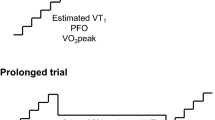Abstract
The purpose of this study into high-intensity cycling was to: (1) test the hypothesis that endurance time is longest at a freely chosen pedalling rate (FCPR), compared to pedalling rates 25% lower (FCPR−25) and higher (FCPR+25) than FCPR, and (2) investigate how physiological variables, such as muscle fibre type composition and power reserve, relate to endurance time. Twenty males underwent testing to determine their maximal oxygen uptake (V̇O2max), power output corresponding to 90% of V̇O2max at 80 rpm (Ẇ90), FCPR at Ẇ90, percentage of slow twitch muscle fibres (% MHC I), maximal leg power, and endurance time at Ẇ90 with FCPR−25, FCPR, and FCPR+25. Power reserve was calculated as the difference between applied power output at a given pedalling rate and peak crank power at this same pedalling rate. Ẇ90 was 325 (47) W. FCPR at Ẇ90 was 78 (11) rpm, resulting in FCPR−25 being 59 (8) rpm and FCPR+25 being 98 (13) rpm. Endurance time at Ẇ90FCPR+25 [441 (188) s] was significantly shorter than at Ẇ90FCPR [589 (232) s] and Ẇ90FCPR−25 [547 (170) s]. Metabolic responses such as V̇O2 and blood lactate concentration were generally higher at Ẇ90FCPR+25 than at Ẇ90FCPR−25 and Ẇ90FCPR. Endurance time was negatively related to V̇O2max, Ẇ90 and % MHC I, while positively related to power reserve. In conclusion, at group level, endurance time was longer at FCPR and at a pedalling rate 25% lower compared to a pedalling rate 25% higher than FCPR. Further, inter-individual physiological variables were of significance for endurance time, % MHC I showing a negative and power reserve a positive relationship.





Similar content being viewed by others
References
Ahlquist LE, Bassett DR Jr, Sufit R, Nagle FJ, Thomas DP (1992) The effect of pedaling frequency on glycogen depletion rates in type I and II quadriceps muscle fibers during submaximal cycling exercise. Eur J Appl Physiol 65:360–364
Beelen A, Sargeant AJ (1991) Effect of fatigue on maximal power output at different contraction velocities in humans. J Appl Physiol 71:2332–2337
Böning D, Gönen Y, Maassen N (1984) Relationship between work load, pedal frequency, and physical fitness. Int J Sports Med 5:92–97
Borg G (1970) Perceived exertion as an indicator of somatic stress. Scand J Rehabil Med 2:92–98
Brisswalter J, Hausswirth C, Smith D, Vercruyssen F, Vallier JM (2000) Energetically optimal cadence vs. freely-chosen cadence during cycling: effect of exercise duration. Int J Sports Med 21:60–64
Coyle EF, Sidossis LS, Horowitz JF, Beltz JD (1992) Cycling efficiency is related to the percentage of type I muscle fibers. Med Sci Sports Exerc 24:782–788
Franch J, Madsen K, Djurhuus MS, Pedersen PK (1998) Improved running economy following intensified training correlates with reduced ventilatory demands. Med Sci Sports Exerc 30:1250–1256
Fregly BJ, Zajac FE, Dairaghi CA (2000) Bicycle drive system dynamics: theory and experimental validation. J Biomech Eng 122:446–452
Hansen EA, Andersen JL, Nielsen JS, Sjøgaard G (2002a) Muscle fibre type, efficiency, and mechanical optima affect freely chosen pedal rate during cycling. Acta Physiol Scand 176:185–194
Hansen EA, Jørgensen LV, Jensen K, Fregly BJ, Sjøgaard G (2002b) Crank inertial load affects freely chosen pedal rate during cycling. J Biomech 35:277–285. Erratum in J Biomech 35:1521 (2002)
Hautier CA, Linossier MT, Belli A, Lacour JR, Arsac LM (1996) Optimal velocity for maximal power production in non-isokinetic cycling is related to muscle fibre type composition. Eur J Appl Physiol 74:114–118
Horowitz JF, Sidossis LS, Coyle EF (1994) High efficiency of type I muscle fibers improves performance. Int J Sports Med 15:152–157
Löllgen H, Graham T, Sjogaard G (1980) Muscle metabolites, force, and perceived exertion bicycling at varying pedal rates. Med Sci Sports Exerc 12:345–351
Marsh AP, Martin PE (1993) The association between cycling experience and preferred and most economical cadences. Med Sci Sports Exerc 25:1269–1274
McCartney N, Heigenhauser GJ, Sargeant AJ, Jones NL (1983) A constant-velocity cycle ergometer for the study of dynamic muscle function. J Appl Physiol 55 212–217
Sargeant AJ (1987) Effect of muscle temperature on leg extension force and short-term power output in humans. Eur J Appl Physiol 56:693–698
Sargeant AJ, Hoinville E, Young A (1981) Maximum leg force and power output during short-term dynamic exercise. J Appl Physiol 51 1175–1182
Seabury JJ, Adams WC, Ramey MR (1977) Influence of pedalling rate and power output on energy expenditure during bicycle ergometry. Ergonomics 20:491–498
Takaishi T, Yamamoto T, Ono T, Ito T, Moritani T (1998) Neuromuscular, metabolic, and kinetic adaptations for skilled pedaling performance in cyclists. Med Sci Sports Exerc 30:442–449
Vercruyssen F, Brisswalter J, Hausswirth C, Bernard T, Bernard O, Vallier JM (2002) Influence of cycling cadence on subsequent running performance in triathletes. Med Sci Sports Exerc 34:530–536
Zoladz JA, Rademaker ACHJ, Sargeant AJ (2000) Human muscle power generating capability during cycling at different pedalling rates. Exp Physiol 85:117–124
Acknowledgements
The present study was financially supported by the Danish Sports Research Council (Grant 980501–14), the Danish National Research Foundation (Grant 504–14), and a grant given to the author Gisela Sjøgaard by the Danish Elite Sports Institution ‘Team Danmark’. The experiments comply with the current laws of Denmark.
Author information
Authors and Affiliations
Corresponding author
Rights and permissions
About this article
Cite this article
Nielsen, J.S., Hansen, E.A. & Sjøgaard, G. Pedalling rate affects endurance performance during high-intensity cycling. Eur J Appl Physiol 92, 114–120 (2004). https://doi.org/10.1007/s00421-004-1048-y
Accepted:
Published:
Issue Date:
DOI: https://doi.org/10.1007/s00421-004-1048-y




